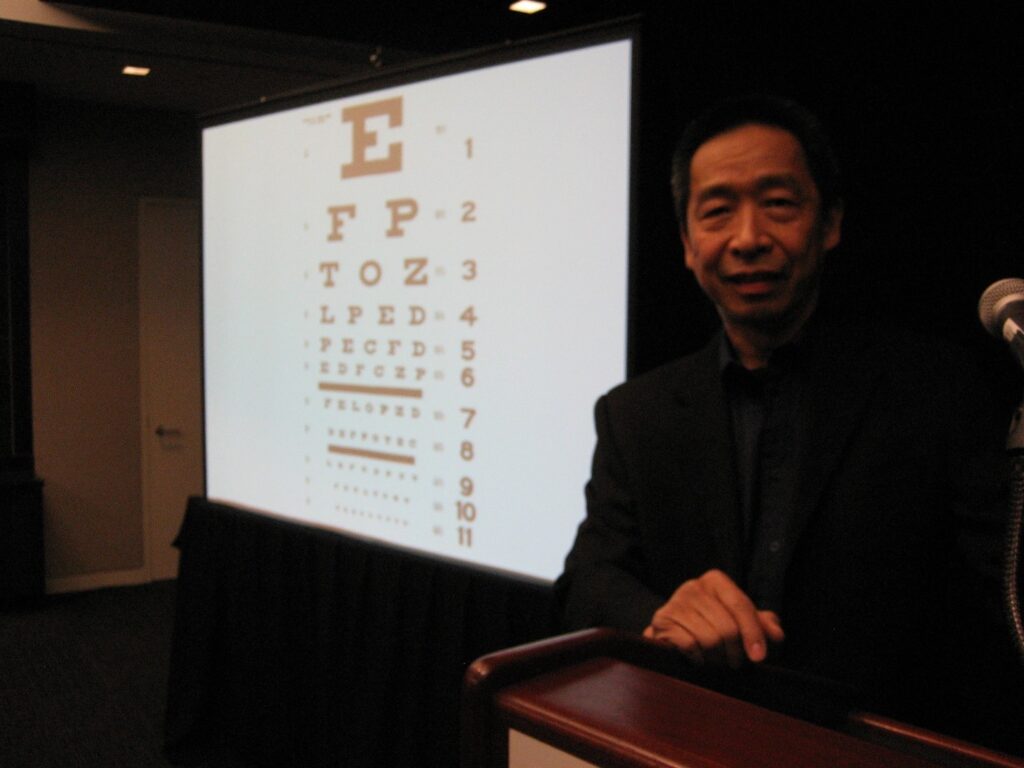
A Biomedical Device
This website is mainly for opticians. But I also welcome the public to check it out. As mentioned in my lectures, I improved the features of an existing lens on the market to prevent myopia from getting worse: an ortho K lens (where the patient would sleep with them on throughout the night—every night).
In contrast, the wearing duration of an ortho C lens is about 5 minutes, and the goal of the wearing frequency is once ever 3 to 6 months. Moreover, the goal is not just to prevent myopia from getting worse—but to correct it. An ortho C lens attends to the whole eye by drawing on the cornea whereas an ortho K lens attempts to flatten the cornea by pressing against it. An ortho C lens is not as flat as an ortho K lens. Therefore, the cornea remains unchanged to allow a constant draw.
An ortho C lens is not a visual aid. It is comparable to a biomedical device. It does not apply physiotherapy. The treatment is a neurological process. The intention is to reduce the elongated myopic eye. The theory behind the treatment is contained in my books and papers listed below.
The Theory
Treating pediatric myopia demonstrates the theory more effectively (Yee, 2020). The synchronization between the lens and eyeball was severed once myopia sets in (Mutti et al., 2012). When the ortho C lens reinstates the correct neuromotor response to synchronize the lens and the eye, it also restores the developmental process. It is mainly the development of the eye that contributes to the treatment (Yee, 2022).
According to the latest research, the pediatric participants only wore the lenses at the beginning of their scheduled follow-up periods for 5 minutes. Their visual acuity would register an improvement, and they were able to retain the improvement by the end of each follow-up period. In some cases, the visual acuity would further improve on its own accord.
The Present Research
I am planning to continue the research at the University of Waterloo towards my postdoctorate. I am seeking volunteers: youths between the ages of 6 and 16 with myopia. Unlike any of the contact lenses on the market, the goal is to correct their myopia instead of just preventing it from getting worse.
Any practitioners or parents interested, contact me at: theeyefix@email.com
For more information on how orthoculogy works, please watch the following video:
Published Journal Articles by John William Yee
- Correcting Mild Myopia by Means of Orthoculogy, 2011, Medical Hypothesis, Elsevier
URL: https://pubmed.ncbi.nlm.nih.gov/21106303/ - Correcting Corneal Astigmatism by Reinstating the Correct Neuromuscular Message, 2012, Medical Hypothesis, Elsevier
URL: https://pubmed.ncbi.nlm.nih.gov/22770871/ - Correcting Lenticular Astigmatism by Reinstating the Correct Neuromuscular Message, 2013, Medical Hypothesis, Elsevier
URL: https://pubmed.ncbi.nlm.nih.gov/23639283/ - Preventing Retinal Detachment by Averting Asthenopia that Contributes to Progressive Myopia, 2013, OA Medical Hypothesis
URL: https://www.semanticscholar.org/paper/Preventing-retinal-detachment-by-averting-that-to-Yee/64fc450fb7d5012bc8ea09c0019e31ecbd287b4f - Neurological Implications in the Treatment of Myopia by Means of Orthoculogy, 2014, Journal of Neurology and Neurophysiology
DOI: 10.4172/2155-9562.1000257 - Neurological and Developmental Implications in the Treatment of Myopia by Means of Ortho C, 2024, Journal of Multidisciplinary Research at Trent. (In press).
- The Application of Expressive Writing as an Intervention for Test Anxiety: Illustrated with the Toronto Police Exams, 2024, Journal of Police and Criminal Psychology, Springer.
DOI: 10.1007/s11896-024-09651-4
URL: https://rdcu.be/dB4vp
Published Books by John William Yee
- The Neurological Treatment for Nearsightedness and Related Vision Problems, 2020, Apple Academic Press, Palm Bay, Florida
URL: www.appleacademicpress.com/title.php?id?=9781771887328 - Dealing with Nearsightedness during Development (and Post-Development), 2022, Cambridge Scholars Publishing, Newcastle, UK (Yee, 2022).
URL: https://www.cambridgescholars.com/product/978-1-5275-8212-5/